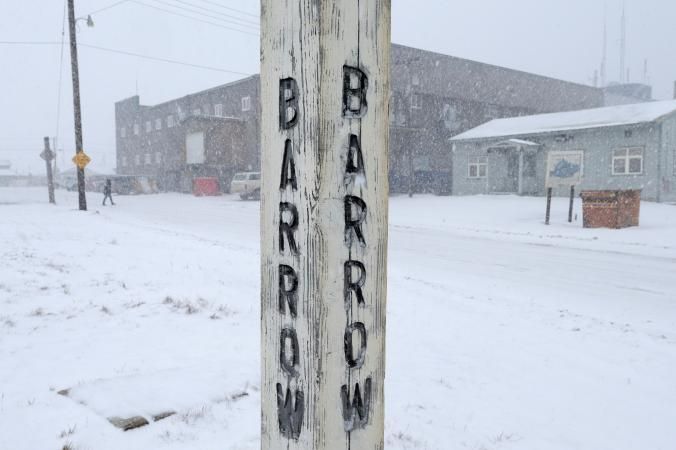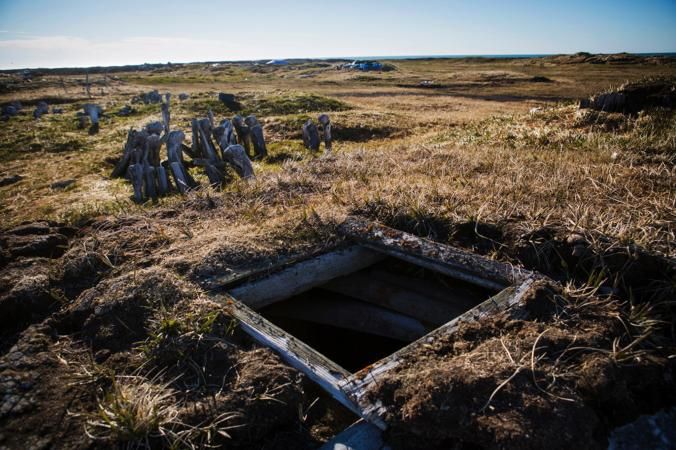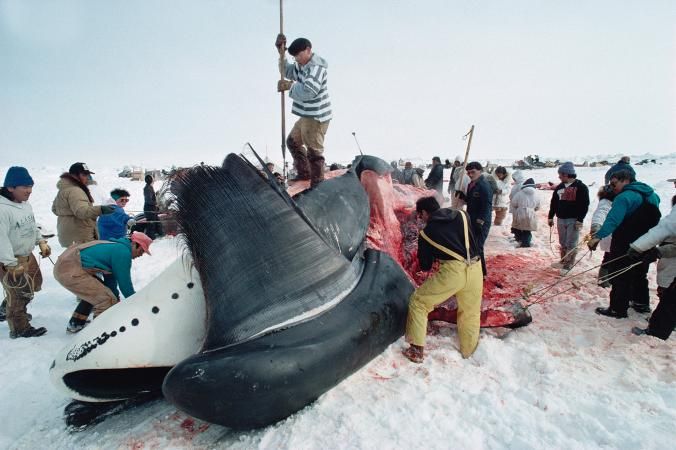Building an underground ice cellar to store bowhead whale and other meat in Barrow, Alaska, is no small task. Even in the summertime, permafrost is hard as a rock a foot or so below the surface.
Last year Herman Ahsoak employed a jackhammer and drill to construct a cellar for the whaling crew he has captained for more than a decade. But in the spring, melting snow penetrated the hatch, and the 14-foot deep cellar “filled all the way to the top with water,” Ahsoak says.
Maintaining ice cellars has always been hard work for subsistence hunters in Barrow, the northernmost city in the United States. But warming temperatures have now rendered many of these underground freezers unusable. (Read about how rising temperature are also threatening desert life.)
Increasingly, ice cellars that generations of native Alaskan communities have relied upon for storing food are melting, according to tribal elders and researchers. In addition to the warmer temperatures, coastal erosion and geologic ground disturbances are exacerbating the thaw.
“For many cellars even if [the temperature is] below freezing it’s not cold enough to keep meat safely,” says geophysicist Vladimir Romanovsky of the University of Alaska, Fairbanks.
As a result, some Arctic residents are scrambling to find new, safe ways to store their meat. (Read about what animals may go extinct first due to climate change.)
“This was never a problem before,” says Larry Aiken, a Barrow town elder and harpooner on a whaling crew.
Filling Up With Water
The Inupiat hunt for whale, walrus, seal, caribou, and fish, but yields from subsistence hunting ebb and flow unpredictably, making ice cellars, which generally sit 10 to 12 feet below the surface, critical for storing meat for lean months. Often shared by several families in a whaling crew, some cellars are accessed through small huts; plywood hatches cover others. (Read about how the warming Pacific Ocean makes for increasingly weird ocean life.)
Barrow’s main store, the AC Value Center, offers food delivered by plane for locals who run out of their meat and fish. But much of this processed food is not as healthy as their traditional foods, which are full of protein, minerals, fatty acids, and other nutrients.
“There have been so many cellars that have filled up with water,” says Emma Neakok, who makes dolls and other products she sells in the store lobby. Neakok says Barrow’s poorer residents can barely afford to buy processed food, let alone the multiple chest freezers that would be needed to store whale meat. “All that food – it’s not going to fit in a [kitchen] freezer,” she says.
About percent of Barrow's 1,500 households rely on subsistence foods for half or more of their diet, making food sharing and storage particularly important.
Melting ice cellars bedevil hunters and fishermen across the Arctic, says Nikita Zimov, director of the Northeast Science Station in Cherskiy, Russia. As the permafrost warms, he says, proper cellar maintenance is more important than ever.
“A lot of people in this region don’t maintain their ice cellars properly,” he says. Opening the freezer so cold air circulates is essential, as is removing meat in spring and spreading fresh snow on its floor.
Spiritual considerations are at play as well as practical ones. “You have to clean out your ice cellar cause the whale won't give itself unless it has a clean place to rest,” a Barrow Inupiat woman said in oral interviews.
Barrow resident Richard Glenn designed his cellar with a changing climate in mind. After a crack allowed water to penetrate it, he insulated its hatch with blocks of sod. “I intentionally dug a cellar that is a little deeper than most – I think I am about 22 feet below surface – to buy time against a net warming at the surface,” says Glenn.
Scientists Debate Causes
The local tribal government teamed with academic scientists in 2010 to determine why certain cellars thaw and others don’t. But five years later there’s no definitive answer. Since the 1980s, the annual depth of thaw in Barrow hasn’t changed much but permafrost temperatures 20 feet below the surface have risen between 2 and 3 degrees Fahrenheit (1 to 1.5 degrees Celsius). And since the 1950s, average air temperatures have spiked by more than 5 degrees Fahrenheit.
Romanovsky says that warmer air means more opportunities for water to ruin cellars via cracks, creating a chain reaction that thaws more walls and allows more water in. Plus in recent years Barrow has received more snow, which provides more moisture.
However, scientist Kenji Yoshikawa at University of Alaska, Fairbanks, questions the climate link, citing measurements that show no warming within several Barrow cellars. Instead, he pins the blame more on geologic disturbances or coastal erosion, which also can allow water in laterally. Both scientists agree that an underground tunnel, known as the Utilidor, built in Barrow in 1984 to provide water, electricity, and other utilities was responsible for the failure of some cellars.
This summer, Price Leavitt, a Barrow construction contractor and subsistence hunter, entered the ice cellar he built four years ago. Gaining access means removing a tarp and plywood doors. “You can see tiny icicles on the surface of the walls,” says Leavitt. “Which is good news, because it means I can make it bigger.”
Leavitt is concerned about his father’s ice cellar, which was built four decades ago. Without the protective frozen layer on the walls, dirt is flaking off, which could allow water to penetrate into the cellar. Leavitt was shocked to find slush on the bottom of a friend’s cellar in January of 2010, when outside temperatures were below zero degrees Fahrenheit. “Everything looked frozen but the meat had started stinking,” he recalls.
The Inupiat have always been quick to adopt technology when it suits their needs. Many homes in Barrow feature chest freezers, delivered to town on cargo ships. And having lost their ice cellars, several whaling crews have in recent years shared walk-in freezers with scientists at the Naval Arctic Research Laboratory complex on the outskirts of town. In Cherskiy, area fishermen are now transitioning from a giant Lednik, the Russian word for cellar, built during the Soviet era, to an above-ground facility that should make shipping fish by boat easier.
Economic Progress or Cultural Loss?
For some, storing meat in the kitchen instead of underground is a sign of economic progress.
“Maintaining ice cellars is a ton of hard work in the best of times so one reason why freezers may be used more now is that walk-in freezers are available. And folks have more money and less off-work time than 40 years ago,” says Craig George, a biologist with the North Slope Borough who collaborates with whaling crews.
But this shift comes at a cultural and culinary price, says Gordon Brower, an official with the North Slope Borough and subsistence hunter. His home in Barrow includes several chest freezers in the kitchen but he prefers meat frozen in the cellar.
“The cellar allows the slow aging of the meat you can’t get in a freezer,” Brower says. “It’s a different taste and a break from our heritage.”
For the time being, Ahsoak is using a relative’s cellar to store his crew’s meat, but come whaling season next spring, he worries that the “quite small” cellar may not provide adequate storage. Earlier this month, Ahsoak’s crew caught a bowhead whale that yielded roughly 47 tons of meat. “So I’m going to get my crew and jackhammer my down through the ice,” he says.







